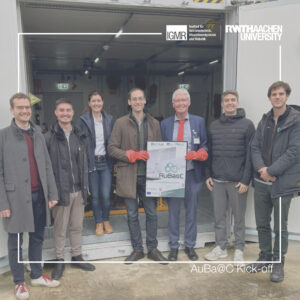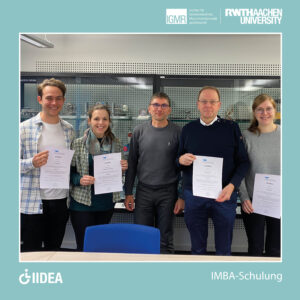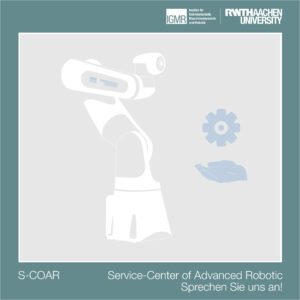November 7th, 2024 | by
Jansen, Christina
Fully automatic disassembly with precision!
Our new robotic system is revolutionizing the disassembly of electric car batteries. Using the Neura Lara 8 robot and the latest image processing technologies, we recognize screws fully automatically and position the robot precisely to remove them safely.
Thanks to the integration of YOLOv8 and Intel RealSense depth cameras, the system can locate screws in real time and position them optimally on its own. No manual intervention necessary – the system works completely autonomously!
Our goal: to make the recycling process safer, faster and more efficient. Fewer risks for workers and maximizing the recovery of raw materials at the same time. This is the future of the circular economy!
You can find more information about #dimonta here.
contact:
Markus Schmitz
Daniel Gossen
Kategorie: AI Task Planning, Algorithmen, Automated Task Planning, dimonta, Industrial Robotics, Industrial Scenario, Industrie, Industrie 4.0, industrielle Robotik, KI, KI Aufgabenplanung, KI Objekterkennung, künstliche Intelligenz, Objekterkennung, Roboter, Roboterprogrammierung, Robotic Systems, Robotik, ROS, Sensor
No Comments »
October 31st, 2024 | by
Jansen, Christina
At the ASME IDETC-CIE conference in Washington, DC, we had the opportunity to present the prototype of the “3D Capsule Compliant Gripper”. This novel surgical manipulation tool was specifically designed to make lymph node isolation even more precise and gentle.
Our approach: a capsule-like structure with flexible, shape-optimized elements that have been tailored using a hill-climbing mutation algorithm. The white “petals” of the prototype were 3D printed from PLA, the red flexible components from TPU. Thanks to the cost-effective production at our institute, we were able to create the first efficient solution on a macro scale, which serves as a proof of concept.
Contact: Estefania Hermoza Llanos
Kategorie: IGMR, Industrie 4.0, industrielle Robotik, Roboter, Roboter unterstützter Patiententransport, Roboterprogrammierung, Robotik
No Comments »
October 1st, 2024 | by
Ruland, Stefan Wolfgang
Der an dieser Stelle eingebundene Inhalt führt Sie auf Seiten, die von der von Google betriebenen Seite YouTube - YouTube, LLC, 901 Cherry Ave., San Bruno, CA 94066, USA - zur Verfügung gestellt werden. Mit dem Aufruf des Inhalts kann YouTube Ihre IP-Adresse und die Sprache des Systems, sowie verschiedene browserspezifische Angaben ermitteln. Wenn Sie in Ihrem YouTube-Account eingeloggt sind, ermöglichen Sie YouTube, Ihr Surfverhalten direkt Ihrem persönlichen Profil zuzuordnen. Dies können Sie verhindern, indem Sie sich aus Ihrem YouTube-Account ausloggen. YouTube verwendet Cookies und Tracking-Tools. Die Datenverarbeitungsvorgänge sowie die Zwecke der Verarbeitung können direkt bei YouTube erfragt und eingesehen werden.
In this video, Prof. Mathias Hüsing of the Institute of Mechanism Theory, Machine Dynamics and Robotics at RWTH Aachen University explains simple teaching options for collaborative robots, or CoBots for short, to support disabled and limited persons at work in the context of human-robot collaboration.
Robotics enables inclusion.
More Information about the IIDEA Project can be found at the project website
https://www.iidea.rwth-aachen.de/cms/~badhmp/iidea/?lidx=1
Kategorie: Cobot, IGMR, Industrie, Inklusion, inklusive Arbeit, Inklusive Arbeitsplätze, Kollaboration, kollaborierenden Roboter, Mensch-Maschine-Kollaboration, Mensch-Roboter-Kollaboration, Roboter
No Comments »
May 7th, 2024 | by
Jansen, Christina

Our IIDEA-project team took part in a training course on the “Integration of people with disabilities into the world of work” (IMBA).
IMBA is positioned at the interface of medical and occupational rehabilitation and enables a precise description and comparison of work requirements and human abilities. The training covered the basics of IMBA, with a particular focus on the defined characteristics that serve as the basis for the assessment of work requirements and abilities. A highlight of the training was the introduction to the “Marie Plus” software, which is closely linked to the IMBA concept. The training was conducted by Torsten Alles, Ph.D., Managing Director of iqpr. His extensive knowledge and experience helped to emphasize the importance of IMBA in occupational therapy and activity-based medical rehabilitation.
We are convinced that this training will support our previous research and make a valuable contribution to the IIDEA project. We are grateful for the expertise we have gained through this training and look forward to applying the acquired knowledge in our daily work.
Here you can find more information about the IIDEA project.
contact person:
Mathias Hüsing
Carlo Weidemann
Elodie Hüsing
Sophie-Charlotte Keunecke
Christina Jansen
Kategorie: Allgemein, Aufgabenplanung, C++, Data Lake, IGMR, Industrie 4.0, Inklusion, inklusive Arbeit, Inklusive Arbeitsplätze, MDAM, Mensch-Maschine-Kollaboration, Mensch-Roboter-Kollaboration, Mobile Robotics, Mobile Robotik, Planung, Prototypenbau, Regelung, Roboter, Trajektorie
No Comments »
April 18th, 2024 | by
Jansen, Christina
https://youtu.be/AapssdrPeMQ?feature=shared
Delta robots are the most common parallel robots for manipulation tasks. In many industrial applications they must be operated at reduced speed or dwell times have to be included in the motion planning, to prevent frame vibrations. As a result, their full potential cannot be realized. To address this problem, this we developed the mechanical and control design of an active dynamic balancing unit for reduction of frame vibrations. In this video you can see the experimental validation of this system in a pick and place scenario. It the proposed active dynamic balancing unit provides a significant vibration reduction of about 85% for translational and 78% for rotational vibrations. The experiments were conducted on a low cost Delta robot called the Suisui Bot designed at the IGMR, in collaboration with the Tokyo Institute of Technology. Two different strategies have been proposed for the control of the balancing unit. In this video you can see the IMSC in combination with a open-loop control based on the robots inverse dynamics. Please refer here for further information on the design and control system.
contact: Christian Mirz
Kategorie: Delta, Roboter
No Comments »
December 18th, 2023 | by
Jansen, Christina

Our expertise extends to the seamless integration of robots into test benches, the optimization of showcases with existing robots and the adaptation of measurements and sensor technology for an automated solution using robots.
Robots are playing an increasingly important role in a wide range of research projects. However, there is often a lack of expertise and time to use them effectively and in a user–friendly way – and this is exactly where we come in!
Our services include:
– The integration of robots into your test benches
– The further use of existing robots for showcases
– The adaptation of measurements and sensors using robot technology
– Troubleshooting for robots
– Planning and implementation of research projects with the use of robots
– Ideas and support for automation in various specialist areas
Dr. Markus Schmitz is your contact for the implementation and planning of automation projects and for technical advice. Please send requests for quotations to scoar@igmr.rwth-aachen.de.
Kategorie: Allgemein, Roboter, Robotik
No Comments »










